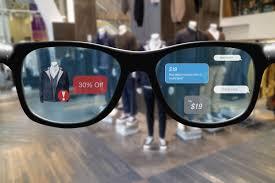Augmented Reality Glasses Market Growth Challenges Slow Widespread Industry Adoption
The augmented reality (AR) glasses market holds the promise of transforming industries and everyday experiences by seamlessly merging digital content with the physical world. These devices have attracted attention across sectors including healthcare, manufacturing, gaming, retail, and enterprise solutions, offering benefits like hands-free data access, immersive training, and real-time navigation. However, despite the potential, the AR glasses market has struggled to achieve widespread commercial adoption. Multiple growth challenges continue to hinder its expansion. This article explores the core obstacles slowing down the AR glasses market and discusses paths forward.

1. High Product Costs
One of the primary barriers to widespread adoption of AR glasses is their high price point. Advanced AR glasses incorporate components such as high-resolution displays, sensors, waveguides, processors, and cameras, all of which significantly drive up production costs. Many high-end models are priced out of reach for the average consumer, limiting adoption to enterprise and niche professional markets. Until costs come down through economies of scale or component innovation, mass-market penetration will remain limited.
2. Limited Consumer Use Cases
For the average consumer, compelling everyday applications of AR glasses are still lacking. While enterprise use cases—such as remote assistance, warehouse operations, or surgical navigation—are clear, mainstream consumers are yet to see enough practical benefits to justify the purchase. Without strong consumer-facing apps that offer real utility or entertainment, AR glasses struggle to move beyond tech enthusiasts and early adopters.
3. Bulky Design and Comfort Issues
Many current AR glasses models are relatively bulky or awkward in design, which can make them uncomfortable for long-term wear. Weight, size, and aesthetic appeal are critical factors for adoption—especially for consumers. While technological progress is being made, striking a balance between functionality and user comfort remains a significant design challenge.
4. Battery Life Constraints
Running immersive applications with real-time data processing and display significantly drains battery life. Many AR glasses offer limited operational time before requiring a recharge, which restricts their usability, especially in mobile or field environments. Improving battery efficiency without increasing weight or size is an ongoing technical hurdle.
5. Software and Content Ecosystem Gaps
The availability of engaging and useful AR-specific software is essential for driving user adoption. However, the ecosystem for AR apps and platforms is still underdeveloped compared to smartphones or even virtual reality (VR). Developers often face challenges with fragmentation across hardware platforms, limiting their ability to create widely compatible experiences.
6. Privacy and Security Concerns
AR glasses often include front-facing cameras and real-time location tracking, raising significant privacy issues. Users and bystanders alike may feel uncomfortable with the potential for surveillance or data collection. Regulatory scrutiny, combined with consumer hesitance around wearable tech, adds friction to broader adoption.
7. Technical Limitations in Real-World Environments
Current AR glasses often struggle with usability in variable lighting conditions, like bright sunlight or low light. Additionally, accurate tracking, gesture recognition, and display clarity can be inconsistent in complex physical environments. These performance limitations hinder user trust and reliability, especially in professional settings.
8. Lack of Standardization and Interoperability
The AR market is fragmented, with different manufacturers developing proprietary hardware and software stacks. This lack of standardization leads to compatibility issues between devices and applications, impeding developer enthusiasm and consumer confidence. Without a more unified ecosystem, achieving scale remains difficult.
Strategies to Overcome Market Challenges
-
Cost Reduction Through Scalable Manufacturing
Manufacturers need to streamline production processes and reduce reliance on expensive components. Strategic partnerships with component suppliers and investment in alternative materials may help make AR glasses more affordable. -
Consumer-Centric App Development
Developers should focus on creating practical, daily-use applications in areas like fitness, education, navigation, and social interaction. Collaboration with consumer brands can lead to more engaging content ecosystems. -
Design Innovations
Emphasis on lightweight materials, ergonomic frames, and discreet form factors will help overcome wearability concerns. Integrating AR technology into conventional eyeglass designs can make devices more acceptable for everyday use. -
Extended Battery and Power Efficiency
Research into low-power processors and display technologies like micro-LEDs can help improve battery life. Removable battery packs or companion devices may also enhance operational time. -
Robust Privacy Controls
Implementing strong data protection measures and transparent user permissions can help mitigate privacy fears. Developing clear visual indicators for recording and AR activity can improve user and public trust. -
Hardware and Software Standardization
Industry alliances that work toward common platforms and development standards will encourage innovation and broader software support, enabling a more cohesive AR ecosystem.
Conclusion
The augmented reality glasses market is brimming with transformative potential, yet a combination of technical, economic, and societal challenges continues to slow its widespread adoption. High costs, lack of clear use cases for consumers, hardware design limitations, and privacy concerns are among the key factors that must be addressed. As technology evolves and the industry shifts focus toward usability, interoperability, and affordability, AR glasses are expected to become more accessible and useful. Strategic collaboration, user-centric innovation, and sustained investment will be essential in unlocking the next stage of growth for the AR glasses market.
- Art
- Causes
- Crafts
- Dance
- Drinks
- Film
- Fitness
- Food
- Games
- Gardening
- Health
- Home
- Literature
- Music
- Networking
- Other
- Party
- Religion
- Shopping
- Sports
- Theater
- Wellness


